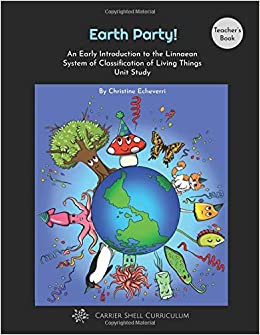Earth Party! is a twelve-week, secular unit study for students in grades one through six that teaches students about the classification of living things based on the work of Karl Linnaeus. You should be able to complete each of the course’s six chapters over about a two-week span, with lessons on two or three days a week.
You need both the teacher book and student book that are published by Carrier Shell Curriculum. You will also need three other required literature and resource books:
- Tree of Life by Rochelle Strauss
- The Kingfisher Science Encyclopedia
- Karl, Get Out of the Garden! by Anita Sanchez
A fourth book, Natural History: The Ultimate Visual Guide to Everything on Earth (from DK™) is recommended but not required. References to pages in this book are included in the lessons, primarily for their images rather than for the printed information.
Rather than delve into all of the complexities of the classification system, this study focuses on the five kingdoms of living things, and some of the classifications below that level. For example, students learn about the differences between vertebrates and invertebrates then become familiar with examples from groups within each category. The course presents information simply enough to be understood by students in the elementary grades. Even so, some of the vocabulary will probably be challenging for younger students.
The first of the course’s six chapters focuses on Karl Linnaeus, and the other chapters cover the various kingdoms of living things. Within each chapter, students are assigned reading in the required books. Parents can read the assignments aloud if that works better. The teacher’s book has discussion questions for the assigned reading, and the student book has additional questions with lines for students to write their answers, along with occasional images to label. Parents might use the workbook questions orally if that works better for a child. Sometimes the assigned reading is just a few pages long, and the questions for that reading can easily be answered in one session. Other times, the reading passages are longer, and you might want to use the questions over a number of days. For instance, page 25 in the teacher’s book assigns nine pages to read from The Kingfisher Science Encyclopedia and follows with six sets of questions under the headings Marine Invertebrates; Mollusks; Worms; Crustaceans; Spiders, Centipedes, and Scorpions; and Insects. In instances like this, you might work through only one or two of the groups of questions on a single day.
Every chapter lists one or more recommendations for videos (with URLs), primarily on YouTube®. There is a quiz at the end of the course, and answers for both the chapter questions and the quiz are in the teacher’s book.
Activities
Activities are included in every chapter, with additional “Cross-Chapter Exploration Projects” following the sixth chapter. The chapter activities are designed so that there are some to meet the needs of children with diverse learning styles. So they include arts and crafts, microscope observations, collecting items from nature, research and writing, drawing, creating acrostics, and more. Some activities require pages from the student book, and other required materials are listed when they are needed. Microscope activities are included frequently enough that students must have access to a microscope.
A memory game is included among the activities for most chapters. A set of 80 memory game cards is at the back of the teacher’s book and also on the publisher's website (as a free download). Forty cards have the name of one kingdom or of both a kingdom and phylum—many are duplicates. The other 40 cards have characteristics of something that is a member of the kingdoms or phylum listed on the first 40 cards. For example, the card that says, “Fungi” can be matched with the card that says, “Examples include: mushrooms, yeast, and lichen.” The teacher's book is available only in print, and you can copy the pages with the cards onto cardstock and cut them. But it's much easier to print these out from the PDF.
Before starting the second chapter of the course, students should choose one of the Cross-Chapter Exploration Projects to work on. These are larger projects that will take time to complete. As with the other activities, they address the needs of students with different learning styles by offering choices such as participating in a scavenger hunt, designing a kingdoms-related theme park, creating dances that relate to the animal kingdoms, researching information, and completing charts that are found in the student book. Choose the activities that work best for your children, since they are not expected to complete all of them.
Summary
Earth Party! can be used with children across a fairly wide age span as long as you select and adapt activities to suit each child. The secular nature of this course makes it suitable for just about everyone—it avoids contentious issues about how things came into existence. The information it teaches is more advanced than what most children in first and second grade are expected to learn, but if you use the memory game and activities, it should help you create an enjoyable and effective learning experience.









